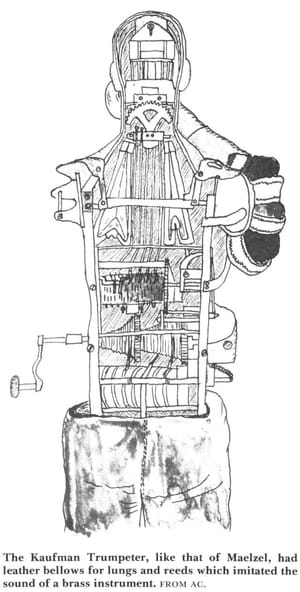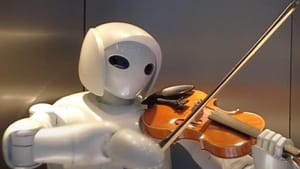Within the captivating realm of automata, where art intertwines with engineering and ingenuity blossoms, Friedrich Kaufmann's 1810 Automaton Trumpet Player emerges as a symphony of mechanical precision.
This intricate creation, a testament to human inventiveness and a mesmerizing embodiment of the era's technological aspirations, beckons us to delve into its melodious world.

Friedrich Kaufmann
Friedrich Kaufmann (February 5, 1785 – December 1, 1866) was a German musical instrument maker known for his automatons, particularly his 1810 Automaton Trumpet Player. Born in Dresden, Germany, Kaufmann apprenticed under his father, Johann Gottfried Kaufmann, a skilled clockmaker and instrument maker. He inherited his father's workshop and continued the family's tradition of crafting exquisite musical instruments and automatons.
Kaufmann's 1810 Automaton Trumpet Player is widely considered his masterpiece. This intricate automaton replicates the actions of a human trumpeter, producing a range of notes and articulations. It is considered one of the most sophisticated and lifelike automatons ever created.
A Mechanical Maestro
Crafted in 1810 by the esteemed German craftsman exact, this automaton stands as a marvel of mechanical engineering. Its intricate design, an intricate combo of gears, bellows, and reeds, meticulously replicates the actions of a human trumpeter. As the automaton's bellows rhythmically expand and its trumpet valves maneuver with precision, an uncanny illusion of a real musician in performance unfolds before our eyes.

Decoding the Orchestration of Sound
At the heart of the automaton's ability to produce sound lies a sophisticated interplay of air pressure and carefully tuned reeds. A spring mechanism within the automaton's body powers a bellows, generating a steady stream of air. This air embarks on a meticulously choreographed journey through a series of valves controlled by a rotating drum studded with pins.
These strategically positioned pins, like conductors orchestrating a musical ensemble, activate the valves in a precise sequence, allowing air to serenade specific reeds. The reeds, meticulously crafted from metal, vibrate in response to the air's serenade, producing the trumpet's characteristic tones. The automaton's ability to reproduce a range of notes stems from the varying lengths and thicknesses of the reeds, each resonating at its unique pitch.
Friedrich was 200 years ahead of this type of innovation. Toyota has been screening with user groups for the same exact functionality!
A Mechanical Virtuoso in Action
The automaton's performance extends beyond mere sound production; it mimics the nuances of a human trumpeter's technique with remarkable finesse. Its mechanical arms and hands manipulate the trumpet with the precision of a seasoned musician, adjusting its position and manipulating its valves to produce a variety of articulations. The automaton even incorporates a subtle rocking motion, reminiscent of a musician swaying to the rhythm of the music.
A Window into the Technological Dreams of an Era
Friedrich Kaufmann's 1810 Automaton Trumpet Player embodies the technological aspirations of its era, standing as a testament to human ingenuity. Its intricate design and lifelike movements reflect the craftsmanship and technological advancements of the time, while its ability to produce music showcases the growing fascination with replicating human capabilities through mechanical means.

A Legacy of Enchantment
Beyond its technological significance, the automaton remains a captivating work of art, a testament to the power of human creativity to transcend the boundaries of mere functionality.
Its ability to produce enchanting melodies and evoke a sense of wonder continues to captivate audiences today, reminding us of the enduring fascination with automata and their unique ability to bridge the worlds of art, science, and technology.
When I met James at Kirkland Google campus, he shared stories of similar feats (his book is fantastic) and some very touchy; in future posts, I will spill the trumpet...umh I mean the beans on that encounter and his book and how voice in robotics will change everything!

Conclusion
Friedrich Kaufmann's 1810 Automaton Trumpet Player stands as a remarkable confluence of mechanical ingenuity, artistic expression, and technological innovation. Its intricate design, lifelike movements, and ability to produce enchanting melodies continue to inspire and captivate audiences today, reminding us of the boundless potential of human creativity and the enduring fascination with the world of automata.
If you are not as much as Frederich into trumpets, well, there's a whistling bot, too!
As we delve deeper into this mechanical marvel, we are not merely unraveling the intricacies of its design; we are embarking on a journey of wonder and imagination, where the boundaries between art, science, and technology blur, and the melodies of an automaton whisper tales of human ingenuity and the boundless horizons of creativity.







